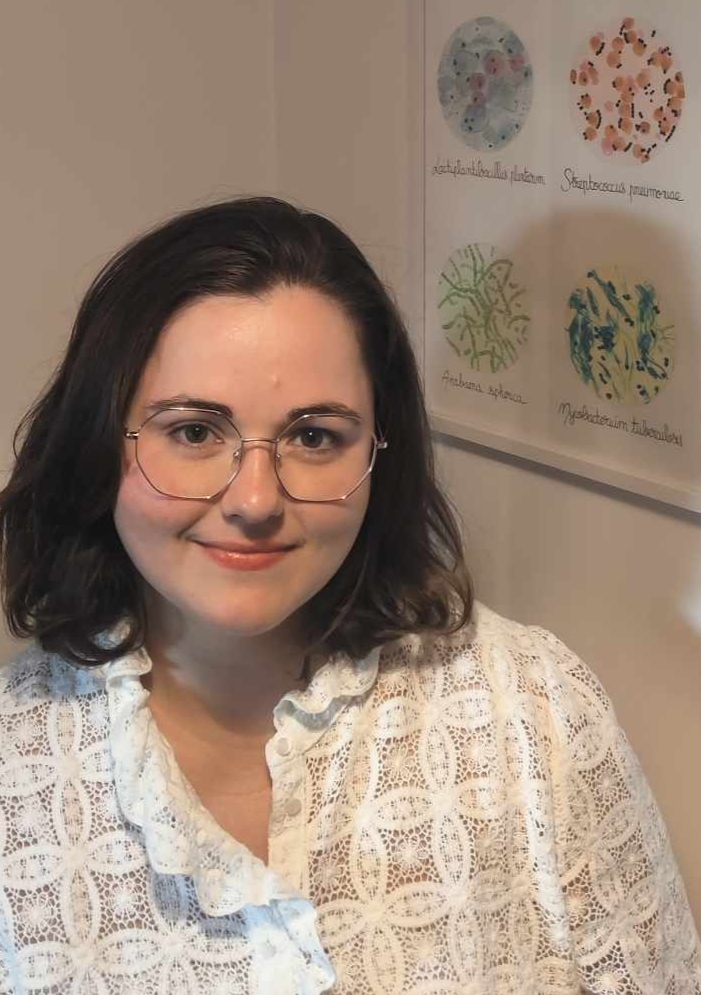MMSB, Lyon The morphogenic protein CopD controls the spatio-temporal dynamics of PBP1a and PBP2b Streptococcus pneumoniae. mBio 14:e01411-23https://doi.org/10.1128/mbio.01411-23 Lenoir C, Pelletier A, Manuse S, Millat H, Ducret A, Galinier A, Doan T, Grangeasse C.
Cv
Cassandra Lenoir, âgée de 26 ans, a débuté son cursus scientifique avec un DUT en analyses biologiques et biochimiques réalisé à Lyon, complété par une Licence avec un "Bachelor of sciences" à Edimbourg, en Ecosse. Elle a ensuite réalisé un Master en Microbiologie à Lyon avant de rejoindre l'équipe Bactéries pathogènes et phosphorylation des protéines dirigée par Christophe Grangeasse (MMSB, Lyon) pour son stage de Master 2 et sa thèse (soutenue en décembre 2023). Tout au long de son parcours universitaire, elle a nourri un intérêt pour les enjeux sociétaux en matière de santé, notamment la problématique cruciale de la résistance aux antimicrobiens. Aujourd'hui, elle occupe le poste de chargée de projets dans une entreprise de biotechnologie française, où elle continue de contribuer à des avancées scientifiques innovantes.
Contact
Covalab, 1 rue Jacques Monod, 69500 Bron
Cette adresse e-mail est protégée contre les robots spammeurs. Vous devez activer le JavaScript pour la visualiser.
Résumé de l'article
Penicillin-binding proteins (PBPs) are key to the assembly of peptidoglycan, the major component of the bacterial cell wall. Although several PBP-specific regulatory proteins have been identified in different species, little is known about how the activity of PBPs is controlled and coordinated during the cell cycle. In this study, we characterize the unknown function protein Spr1400 and demonstrate its regulatory function on two PBPs in Streptococcus pneumoniae. For that, we use a combination of technics ranging from bacterial genetics and protein biochemistry to microscopy imaging. First, we show that pneumococcal Spr1400 localizes late to the cell division septum. Furthermore, deletion of spr1400 results in wider cells. Using co-immunoprecipitation and bacterial two hybrid (B2H), we observe that Spr1400 interacts with two PBPs, the class A PBP PBP1a and the class B PBP PBP2b, which are required for cell elongation. Microscale thermophoresis combined with B2H further reveals that these interactions occur through their transmembrane domains. We also show that Spr1400 co-localizes with PBP1a and PBP2b throughout the cell cycle. Strikingly, deletion of spr1400 alters the dynamics of PBP1a and PBP2b. Indeed, the two PBPs persist longer at the division site and localize later at the division site of daughter cells. Collectively, these data demonstrate that Spr1400, thus named CopD for coordinator of PBP1a and 2b dynamics, is a spatio-temporal regulator of PBP1a and PBP2b required for pneumococcal morphogenesis.




